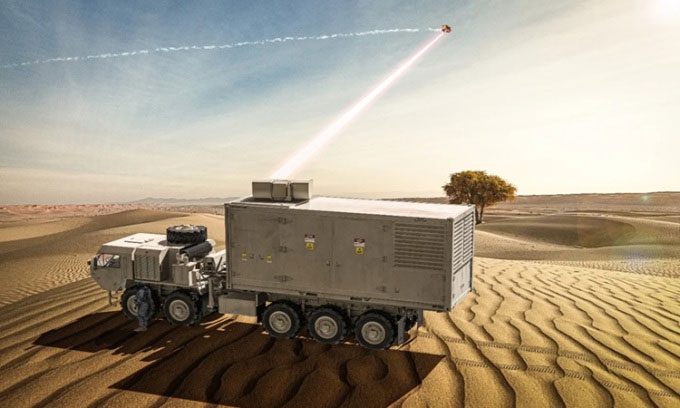Countries around the world are rapidly developing high-powered laser weapons for military operations on land, at sea, in the air, and in space.
The image of clusters of small, inexpensive drones flying through the sky or skimming over the waves has prompted militaries to develop and deploy laser weapons as a replacement for costly defensive measures like missiles, according to Iain Boyd, a professor of aerospace engineering at the University of Colorado Boulder.
Lasers use electricity to generate photons, or light particles. Photons pass through an amplifying medium, rapidly increasing their quantity. All these photons are focused into a narrow beam by a laser guidance system, according to The Conversation.
For decades since the first laser machine was introduced in 1960, engineers have developed a wide range of lasers that produce photons at different wavelengths across the electromagnetic spectrum, from infrared to ultraviolet. High-powered laser systems used in the military are based on solid-state lasers, which use special crystals to convert input energy into photons. A key feature of high-powered solid-state lasers is that the photons are generated in the infrared region of the electromagnetic spectrum, making them invisible to the naked eye.

Laser weapon mounted on a truck. (Photo: Popular Science).
When interacting with a surface, the laser beam produces different effects based on its wavelength, power, and the material of the surface. Low-powered lasers produce photons in the visible spectrum, which can be used as light sources for pointers and displays at public events. These low-powered beams are weak enough to reflect off surfaces without causing any damage.
Higher-powered laser systems are used to cut through biological tissue in various medical processes. The most powerful lasers can heat, vaporize, melt, and burn a variety of materials, and are used in industrial processes for welding and cutting. Besides the power level of the laser, the potential impact is also determined by the distance between the laser and the target.
Laser Weapons
Partially based on the development of high-powered industrial lasers, militaries worldwide are increasingly utilizing laser weapons. A fundamental advantage of high-powered laser weapons is that they can operate continuously. Unlike traditional weapons like guns with limited ammunition, high-powered lasers can fire continuously as long as there is a power source.
The U.S. military is deploying high-powered lasers mounted on trucks to target a variety of threats including drones, helicopters, mortar shells, and missiles. The U.S. Navy is using high-powered lasers on ships for self-defense against fast-moving small boats as well as missiles and drones. The U.S. Air Force is developing high-powered lasers on aircraft for offensive and defensive missions. Russia is also developing high-powered lasers on the ground to “blind” enemy satellites.
Limitations of Laser Weapons
A major challenge for units using high-powered lasers is the amount of electricity required to operate effectively at a distance. Unlike industrial lasers that operate just a few centimeters from the target, military operations often involve much greater distances. To defend against close threats like mortar shells or small boats, laser weapons need to hit the target before damage occurs.
However, igniting materials at a safe distance requires laser beams with power levels ranging from tens to hundreds of kilowatts. The smallest prototype laser weapons use 10 kilowatts of electricity, equivalent to that of an electric vehicle. The latest high-powered laser weapons in development require 300 kilowatts of electricity, enough to power 30 households. Because high-powered lasers are only 50% efficient, they produce significant waste.
This means that high-powered lasers need supporting infrastructure for power generation and cooling, which can limit their effectiveness based on various mounting platforms. Military trucks and fighter aircraft have the least space for high-powered laser systems, so these systems are restricted to relatively low-power targets such as incapacitating drones or neutralizing missiles. Larger ships and aircraft can accommodate more powerful laser systems capable of penetrating boats and ground vehicles. Ground-based systems are the least restricted, thus can achieve the highest power levels and engage missiles from a distance.
Another significant limitation of high-powered laser weapons is related to operating time. Because trucks, ships, or aircraft must carry the power source for the laser, this limits the power output, meaning laser weapons can only be used for limited periods before needing to recharge. Additionally, the effectiveness of laser weapons decreases in rain, fog, and smoke, which can scatter the beam. The laser beam also requires a few seconds to lock onto a target to inflict damage.
In the future, laser weapons are likely to continue developing with increased power levels, expanding their target range.


















































